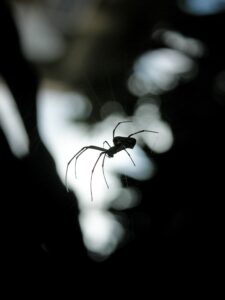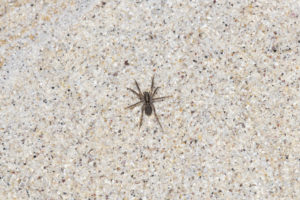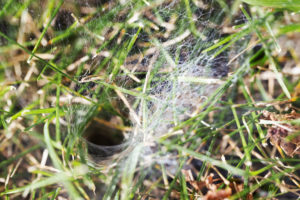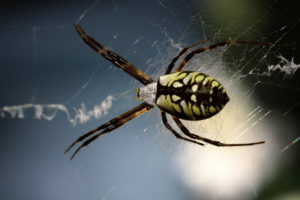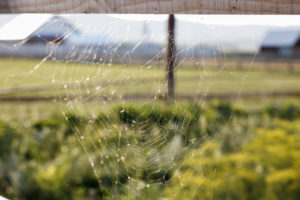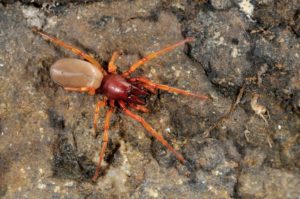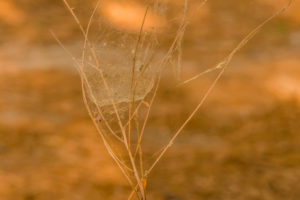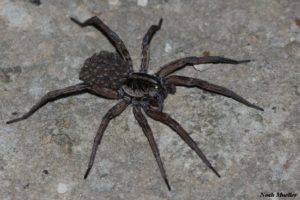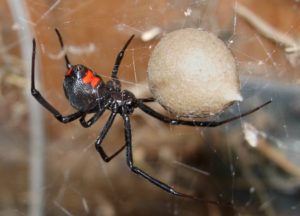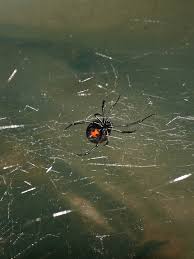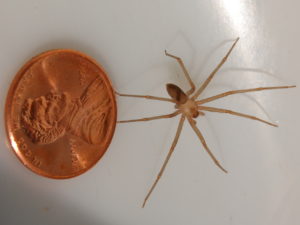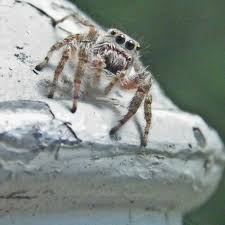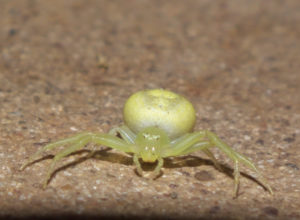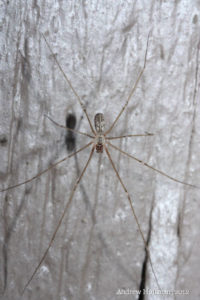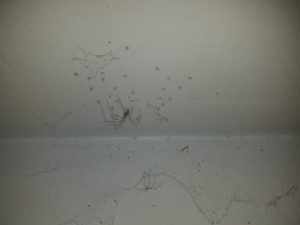Spiders in Austin, Texas
North America is home to over 3,400 species of spiders, ranking 7th in diversity of all organisms. Known as arachnids, spiders are air-breathing arthropods with 8 legs and use their fangs to inject venom into their prey. Texas alone has over 900 species of spiders, with many of them inhabiting Austin, Texas. Although not all venomous, it is key to be able to identify the species you may be in contact with.
While Texas has a large variety of spider species, this article aims to provide the most common types of spiders in Austin, TX.
American Grass Spiders (Agelenopsis)
Physical appearance
The American grass spider is a mostly white cephalothorax with distinctive yellow and black markings on the abdomen. The males range from 5–9 mm (0.20–0.35 in), while the females range from 19–28 mm (0.75–1.10 in) in length.
Web appearance
The web of this species is a somewhat concave, horizontal, sheet-like web with a funnel or tunnel located off to one side. The webs are found on grass, weeds, or ground covers such as ivy, pachysandra, or periwinkle. They can also be found in numerous exterior places such as fencerows, bushes, and brush piles.
Habitat
The name American grass spider derives from the construction of their webs in tall grass, heavy ground cover, or branches of thick shrubs. Rarely will this spider be seen indoors, except for the occasional wandering male.
Are they poisonous to humans?
These spiders are not harmful to humans, as their venom cannot be injected into the skin. This is due to their very small chelicerae, which is not large or prominent enough to pierce human skin. Additionally, their venom is not medically important to humans.
Yellow Garden ORB Weaver Spider (Argiope Aurantia)
Physical appearance
The Yellow Garden ORB Weaver spider can be identified by the dorsal markings on the carapace and abdomen and the greatly elongated hind spinnerets. Females range in size from 10 to 20 millimeters and the males from 9 to 18 millimeters.
Web appearance
The web appearance of the Yellow Garden ORB Weaver spider is a sheet-like web that is somewhat concave, mostly horizontal, and with a funnel or tunnel located off to one side. Their orb webs are very complex and can reach up to 2 feet in diameter.
Habitat
These spiders often build webs in areas adjacent to open, sunny fields where they can stay concealed and protected from the wind. Furthermore, they can also be found along the eaves of houses, outbuildings, or in any tall vegetation where they can securely stretch a web.
Are they poisonous to humans?
Comparable to a bee sting, a bite from this spider results in slight redness and swelling and is not considered an issue for a healthy adult. Though they are not aggressive spiders, those with compromised immune systems, such as the very young or elderly, should exercise caution.
Woodlouse Hunter Spider (Dysdera Crocata)
Physical appearance
Woodlouse Hunter spider females are 11–15 mm (0.43–0.59 in) long, while males are 9–10 mm (0.35–0.39) in length. They have six eyes, are generally dark red in color, and have a shiny yellow-brown abdomen. Most notably, they have very large chelicerae for their size.
Web appearance
The Woodlouse Hunter spider prefers to hunt at night and does not spin webs.
Habitat
These spiders are usually found in warm places under logs, rocks, bricks, leaf litter, or close to woodlice. However, they have also been known to be found in houses. Their days are spent in a silken retreat in the crevices of partially decayed wood, and sometimes construct tent-like structures in indents of various large rocks.
Are they poisonous to humans?
Their venom is non-toxic to humans and verified bites have caused no major medical problems. It has been described that a bite from these spiders feels akin to a bee sting, thanks to their massively large fangs.
Carolina Wolf Spider (Hogna Carolinensis)
Physical appearance
The body length of females for the Carolina Wolf spider is typically 25 millimeters (0.98 in), while the body length of males is typically around 19 mm (0.75 in) in length. Their undersides and abdomen are both solid black, and they have large eyes that are used to reflect light.
Web appearance
This particular species are predators that search and ambush their prey, resulting in no need for spinning webs.
Habitat
As surprisingly poor climbers, these spiders generally remain on the ground, hidden under natural shelters such as the edges of rocks or in their own burrows. When they enter human habitations during the cooler weather in autumn, they tend to remain on the floor.
Are they poisonous to humans?
A bite from this spider is sometimes likened to that of bee or wasp sting. Although people’s responses can vary widely, the venom from this species has been known to cause necrosis lesions.
Black Widow Spider (Latrodectus)
Physical appearance
Female Black Widow spiders are typically dark brown or a shiny black in color when fully grown, and usually exhibit a red or orange hourglass on the ventral surface (underside) of the abdomen. Some females may also have a pair of red spots, although not all will. The male Black Widow spiders often exhibit various red or red and white markings on the dorsal surface (upper side) of the abdomen, ranging from a single stripe to bars or spots. Juveniles will often have similar patterns to the adult male.
Web appearance
The appearance of the Black Widow’s web is discernible and appears to be haphazard, tangled and crisscrossed. They are typically constructed close to the ground, causing leaves and other debris to often get tangled in the web. Additionally, their silk is so strong that if you waved your hand through it, you’d hear it rip.
Habitat
These spiders prefer to nest near the ground in dark, undisturbed areas. Nest sites are often near holes produced by small animals, around construction openings and wood piles, or Low shrubs. Indoors, black widow spiders tend to gravitate to dark, undisturbed sites such as behind furniture or under desks. Undisturbed basement areas and crawl spaces within a home are perfect areas for nesting widow spiders.
Are they poisonous to humans?
Female widow spiders have unusually large venom glands and their bite can be particularly harmful to humans. Only the bites of the females are dangerous to humans. However, despite their notoriety, bites from a black widow spider are rarely fatal or produce serious complications.
The Brown Recluse Spider (Loxosceles Reclusa)
Physical appearance
Brown recluse spiders are usually ranging in size from 6 -20 millimeters (0.24 and 0.79 in), but may grow larger. While typically light to medium brown, they range in color from whiteish to dark brown or blackish gray. The cephalothorax (head and thorax) and abdomen are not necessarily the same color.
Web appearance
Since the web is not intended to catch prey, they tend to appear disorganized and are built most commonly near ground level. Instead, the Brown Recluse roams around searching for prey.
Habitat
These spiders are generally found in woodpiles, sheds, closets, garages, plenum spaces, cellars, or other places that are dry and generally undisturbed. When dwelling in human residences, they seem to favor cardboard, possibly because it mimics the rotting tree bark of their natural habitat.
Are they poisonous to humans?
Although their bite is initially not felt and may not be immediately painful, it can still be serious. The brown recluse bears a potentially deadly hemotoxic venom that may affect a human negatively, although most bites are minor with no necrosis. However, a small number of brown recluse bites do produce severe dermonecrotic lesions (i.e. necrosis).
Grey Wall Jumping Spider (Menemerus Bivittatus)
Physical appearance
The Gray Wall Jumper Spiders are dorso-ventrally flattened and are covered with short, dense, grayish-white hairs. They have tufts of dark brown bristles near the large, forward-facing eyes, and range about 9 millimeters in length. The males tend to be slightly smaller than the females and can be distinguished through their blackish longitudinal dorsal stripe and brownish-white stripe on either side of the abdomen.
Web appearance
These spiders do not spin a web to catch their prey, but instead, stalk their prey before launching an attack by leaping on the victim. They have high visual acuity and their large eyes can focus on objects and detect different colors.
Habitat
These spiders are generally found in grassland and prairie environments, while they can also frequent yards and indoor spaces. Although not intentionally, they enter indoor habitats by being accidentally carried in on plants or a person.
Are they poisonous to humans?
These spiders are not considered a large danger to humans, especially given that these spiders are more likely to run away from people than attack them. Jumping spiders do possess fangs and produce venom, but the venom is not a medical threat.
Crab Spider (Thomisidae)
Physical appearance
Crab spiders are named for their crablike appearance and movements. They scuttle sideways with their hind legs, although some species do move like other spiders. Additionally, they are one of the few species that can reversibly change their body color in a manner that depends on their background. These spiders have two large, strong front legs that are used to grasp prey, and range in size from 4.063-7.62 mm in length (0.16 to 0.3 in).
Web appearance
These spiders don’t spin webs, but they don’t go out to hunt either. Instead, they use camouflage to hide and wait for prey to come to them.
Habitat
This species is considered to be predatory. As this particular spider does not spin a web, they generally reside among leaves or bark, where they await prey and can sit in the open.
Are they poisonous to humans?
These spiders are not known to be harmful to humans since their mouth parts are too small to pierce human skin.
Long-Bodied Cellar Spider (Pholcus phalangioides)
Physical appearance
These spiders are known for their long legs, hence why they are often called “daddy-long-legs.” Females have a body length of about 9 mm (~.3 in) and males are slightly smaller. The length of its legs are about 5 or 6 times the length of its body, reaching a leg span of up to 7 cm (~.27 in) in females.
Web appearance
These spiders build loose, irregular, tangled webs in corners, and hang upside down on the underside of them. The webs are not cleaned, but rather new webs are continually added. This habit can result in extensive webbing in a relatively short time. When disturbed on its web, the Cellar spider has the habit of rapidly shaking its body in a rotary movement to confuse and entangle its prey.
Habitat
These spiders have a habit of living on the ceilings of rooms, caves, garages or cellars. This is due to its inability to survive in cold weather, restricting them to (heated) houses.
Are they poisonous to humans?
Their venom is not toxic to humans. Venom is even less harmful than those of the brown recluse. According to University of California Riverside, “There is no reference to any pholcid spider biting a human and causing any detrimental reaction. If these spiders were indeed deadly poisonous but couldn't bite humans, then the only way we would know that they are poisonous is by milking them and injecting the venom into humans.”
Being able to identify the common spiders in Austin, TX is pertinent information. Whether you have a Cellar spider or Brown Recluse, it is key to understand the dangers and signs of spiders in your area. Knowing whether the spider you come into contact with on a daily basis is poisonous or harmless can severely help everyday situations. Be aware of habits and webs, you know what type of spider may be lurking nearby.
If you do find yourself with an infestation of a common spider, check out our spider pest control services or navigate to our homepage for more information about our pest control services in Austin, TX.

